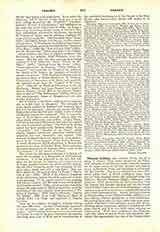

Pakawà, Indians, also written Pacoà, one of a group of cognate tribes, hence designated the Pakawàn (formerly Coahuiltecan) stock, formerly ranging on the upper waters of the San Antonio and Nueces rivers, in Southern Texas, and extending to or beyond the Rio Grande. The group comprised at least fifty small tribes—few of which contained more than two or three hundred souls—the principal being the Pakawà, Payaya, Sanipao, Tilijae, Pamaque, and Xarame. They are notable for their connection with the famous San Antonio missions and for the record which Father García has left of their language, which appears to have been used over a considerable area for intertribal communication. Almost nothing is known of the ethnology of the Pakawàn tribes, which were of low culture, without agriculture or fixed habitation, but roving from place to place, subsisting upon game and the wild fruits of the mesquite, pecan, and cactus, dwelling under temporary shelters of brushwood and grass thatch, and with very little tribal cohesion or organization. While their neighbors, the Tónkawa and other tribes of eastern Texas were notorious cannibals, this was probably not true of the Pakawà who, while inconstant, seem to have been of unwarlike and generally friendly disposition.
The first civilized men to encounter the Pakawàn tribes were the shipwrecked Cabeza de Vaca and his three companions, survivors of the Narvàez expedition, who spent seven years (1529-1536) wandering over the Texas plains before finally reaching Mexico. It is possible also that the Pakawà were represented among the. neophytes whom the Franciscan Father Andres de Olmos drew out of Texas and established under the name of Olives in a Tamaulijas mission in 1544. The earliest known missionary effort among the Pakawàn tribes is that of the Franciscan Damian Massanet (or Manzanet), the father of the Texas missions, who in 1691 stopped at the village of the Payaya tribe, near the present San Antonio, set up a cross and altar and said Mass in the presence of the tribe, explaining the meaning of the ceremony, afterwards distributing rosaries and gaining the good will of the chief by the gift of a horse. Throughout their history the Spanish Texas missions were in charge of Franciscans, directed from the Colleges of Zacatecas and Queretaro in Mexico. In 1718 was established the Spanish presidio, or garrison post, which later grew into the city of San Antonio. In the same year the mission of San Francisco Solano, founded in 1700 on the Rio Grande, was removed by Fr. Antonio de Olivares to the neighborhood of the new post and renamed San Antonio de Valero, famous later as the Alamo. The principal tribe represented was the Xarame. Other establishments followed until in 1731 there were within a few miles of San Antonio five missions, occupied almost exclusively by Indians of Pakawàn stock, viz:
(I) San Antonio de Valero (later, the Alamo)—1718—on San Antonio river, opposite the city. In 1762 it had 275 neophytes. (2) San José y San Miguel de Aguayo—1720—six miles below San Antonio. This was the principal and most flourishing of the Texas missions, and residence of the superior, with what was said to be the finest church in New Spain. In 1762 it had 350 neophytes, and 1500 yoke of work oxen. (3) Purísima Concepción de Acuña (originally a Caddo mission in east Texas), removed 1731 to San Antonio river just below the city. In 1762 it had 207 neophytes. (4) San Juan Capistrano (originally the Caddo mission of San José in east Texas), removed 1731 to San Antonio river about seven miles below the city. In 1762 it had 203 neophytes, with 5000 horses, cattle, and sheep. (5) San Francisco de la Espada (originally a Caddo mission in east Texas), removed 1731 to San Antonio river, nine miles below the city. The chief tribes represented were the Pacao, Pajalat, and Pitalac, numbering together about 1000 souls. In 1762 it had 207 neophytes with some 6000 cattle, horses, sheep, and goats. It was here that Father Garcia wrote his “Manual”. The ruins are locally known as the “fourth mission”.
The missions probably reached their zenith about 1740. In that or the preceding year an epidemic disease wasted the Texas tribes, and about the same time the jealousies of the San Antonio settlers and the increasingly frequent raids of the wild Lipàn and Comanche checked further development. In 1762 an official report showed 1242 neophytes, although the missions were already on the decline. In 1778 smallpox ravaged the whole Texas area, practically exterminating several small tribes. In 1793 the report showed fewer than 300 neophytes remaining in the five missions, and in the next year they were formally dissolved by official Spanish order, provision being made for securing a portion of lands to the few surviving Indians. Some of the monks remained and continued their ministrations for at least ten years longer. In 1801 another smallpox visitation practically completed the destruction of the tribes. In 1886 Dr. Albert Gatschet, of the Bureau of Ethnology, could find only 28 representatives of the stock, all on the Mexican side of the Rio Grande in the neighborhood of Camargo. Excepting for a short vocabulary collected by him, our only knowledge of the language is derived from Fr. Bartholomé García’s “Manual para administrar los santos sacramentos, etc.” (1760), written in Pakawà for the San Antonio missions and published in 1760.
JAMES MOONEY

